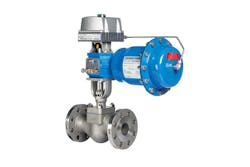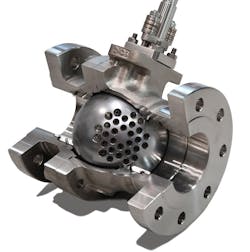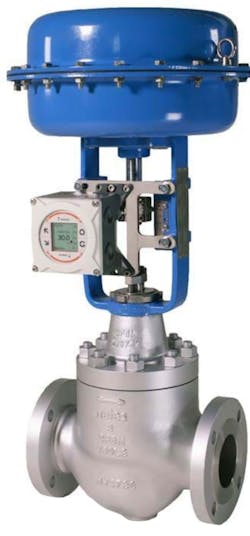Specifying control valves and engineering a system in which the flow of a particular product is completely optimized for superior performance and yield can be a challenging process. A number of factors must be considered during this practice, not the least of which is trying to prevent any system or process-destroying problems that may arise. One of the biggest challenges engineers must confront head-on is the possibility of cavitation in the flow system. Cavitation, if not properly identified and addressed, has the potential to wreak havoc on equipment and disrupt flow. Combine this with the necessity of shutting down the entire operation to fix the problem, and the costs pile up to a very uncomfortable point.
What is cavitation?
Bubbles will form from within the liquid media that is flowing through a particular control valve when the pressure of the liquid drops below its fluid vapor pressure. This is a problem because these bubbles will ultimately disrupt the flow of the liquid, and once the pressure recovers to the optimal state, the bubbles will collapse downstream, causing serious damage to the control valve and downstream equipment. This process is known as cavitation.
The most obvious way to detect cavitation is through sound. There is a noticeable popping sound when the bubbles that have been formed ultimately collapse (pop). This sound can be loud. It is not like hearing popcorn popping on a stove. It’s more like rocks banging into metal. After spending a little time listening to the sound of cavitation occurring in a control valve, it is not hard to believe that there is some serious damage happening inside the valve itself, often in the form of pitting. Making matters worse, this damage does not take long to occur. In as soon as a couple of weeks, the cavitation, if left unaddressed, will cause costly damage. Furthermore, the sound can be so loud that if a plant is in close proximity to a residential area, it is likely that noise complaints will be made. The U.S. Occupational Safety & Health Administration (OSHA) has regulations regarding such excessive noise. There have been incidents in which personnel have been known to experience hearing loss due to prolonged exposure to the noise generated by cavitation.
Cavitation can cause failures of equipment and processes in a short period of time but can also cause long-term damage. Even if equipment does not immediately fail due to heavy cavitation, it will certainly have an adverse effect over time. The constant "microexplosions" that cavitation causes will erode the equipment if they are not addressed in a timely fashion.
It can be difficult and expensive to change out a valve destroyed by cavitation. Having a cavitation protection plan in place can keep valve replacements of this kind off an operator or engineer’s to-do list.
Metso Q-Trim rotary valve
What can be done?
With cavitation being the identified problem, it is important to understand how it can be tempered and avoided. The challenges presented by cavitation can be addressed in a variety of ways. The key, however, is to do as much as possible on the front end of the process, so those in charge of operations do not need to scramble to fix the problem as it occurs.
One example of taking proactive measures to avoid damage-inducing cavitation is introducing more unique solutions downstream. These solutions would come in the form of thicker wall pipe or harder metal. While practically effective, these solutions are not necessarily cost-effective or long-term. The cost associated with the enhanced materials and the productivity lost during this maintenance process often make it an uneconomical approach. It is more sensible to develop a solution to the problem inside the valve itself.
With this approach, however, keep in mind the performance of the valve in the operation. The goal is to solve the cavitation problem with a solution inside of the valve without reducing the valve’s overall performance. Furthermore, there are different solutions depending on the type of valve in question and the type of liquid media being controlled.
Valve variations
Three control valves commonly used in a variety of applications are ball, globe and butterfly. Fortunately, there are certain designs and even specific devices being produced for these different models of valves that can help solve the problem discussed in this article. All three approach the problem from different angles, yet the goal remains the same: to stage the pressure drop over the course of the flow so as not to cause cavitation.
Metso linear globe valve
For ball valves, some designs can prevent the cavitation and noise from happening before it even begins. These specific designs are integrated into the ball to create the staged pressure step-down as the flow passes through. As the liquid media goes through the ball valve, it creates friction and reduces the pressure in steps. This increase in friction will reduce cavitation and potential noise. These valves are typically designed for very high-pressure and high flow coefficient (Cv) applications.
For the butterfly valve specifically, add-on devices can channel the flow, providing for a much higher fluid resistance and staging the pressure across the device. Furthermore, as the valve opens, it creates a pressure that is proportional to the flow, providing an equal percentage inherent characteristic. This is an added benefit that allows the operator to have a far greater range in flow control.
An additional advantage to ball and butterfly valves is their versatility. Due to their wide-open designs, they can handle a much dirtier process media. They are less prone to flow blockage as the flow assists in keeping the valve clean throughout its process.
Concerning globe valves, again, there is a device that can reduce the risk of cavitation and noise, but due to the device’s specific design, attention must be given to the cleanliness of the product flowing through the valve. Unlike the ball valve and butterfly valve solutions, the device associated with the globe valve is designed in a way that can lead to particulate in the liquid media plugging up the holes associated with the device. The advantage, of course, is that globe valves have good range of controllability.
It is also important to note that the viscosity of the product is important when discussing these types of anticavitation devices. For example, if something is particularly thick, like heavy oil, cavitation and the noise it generates can still occur.
Cavitation is a phenomenon that should always be top of mind and taken seriously by control engineers and operation managers when monitoring the flow operation through a specific valve. Proactive steps can and should be taken to avoid all of the problems and rising costs associated with cavitation including equipment failure, flow output and noise pollution.
Kari Kohonen is a strategic account manager for Refining, Oil and Gas for Valin Corporation, a technical solutions provider for the technology, energy, life sciences, natural resources and transportation industries. Valin offers personalized order management, onsite field support, comprehensive training and applied expert engineering services utilizing automation, fluid management, precision measurement, process heating, filtration and fluid power products.



